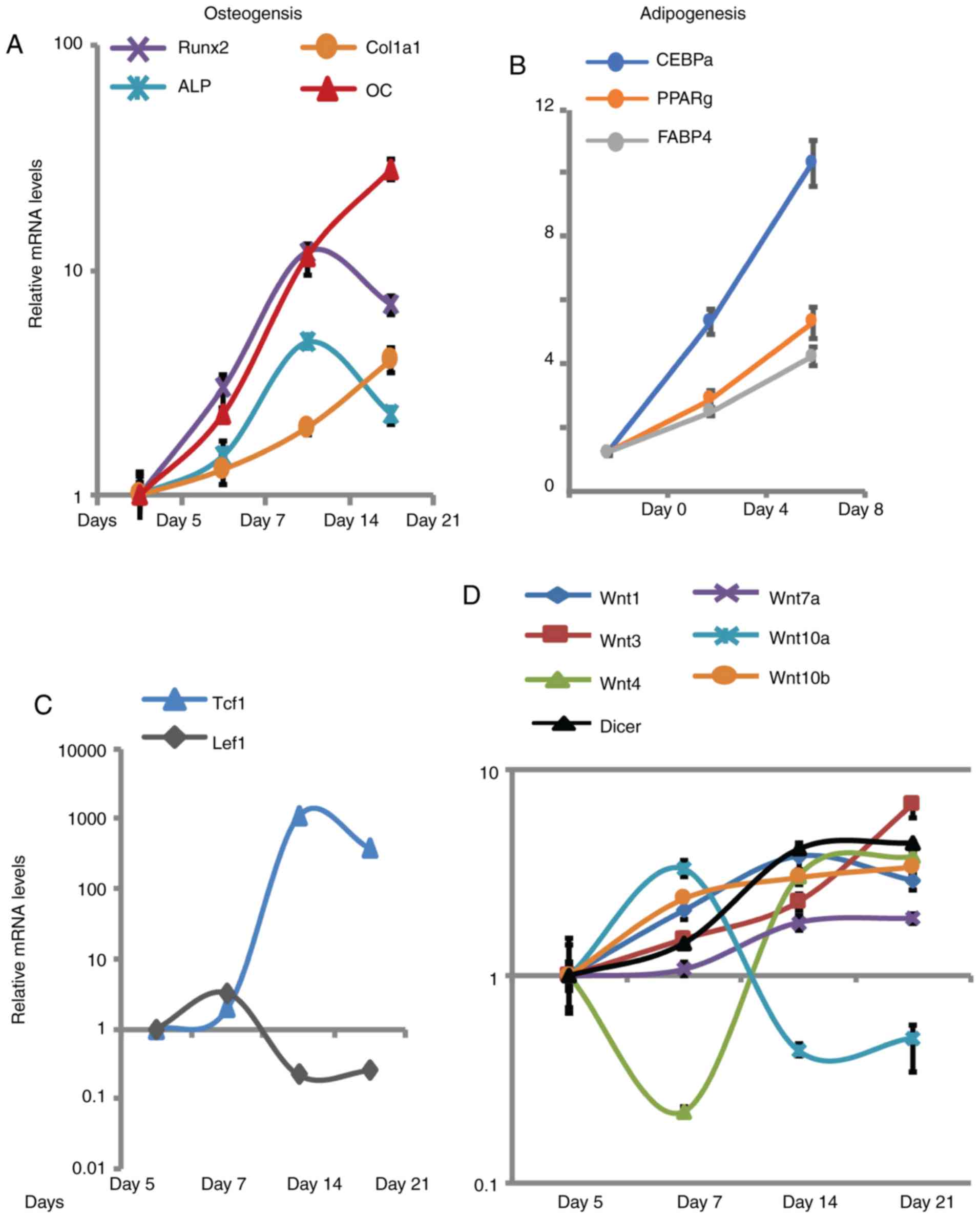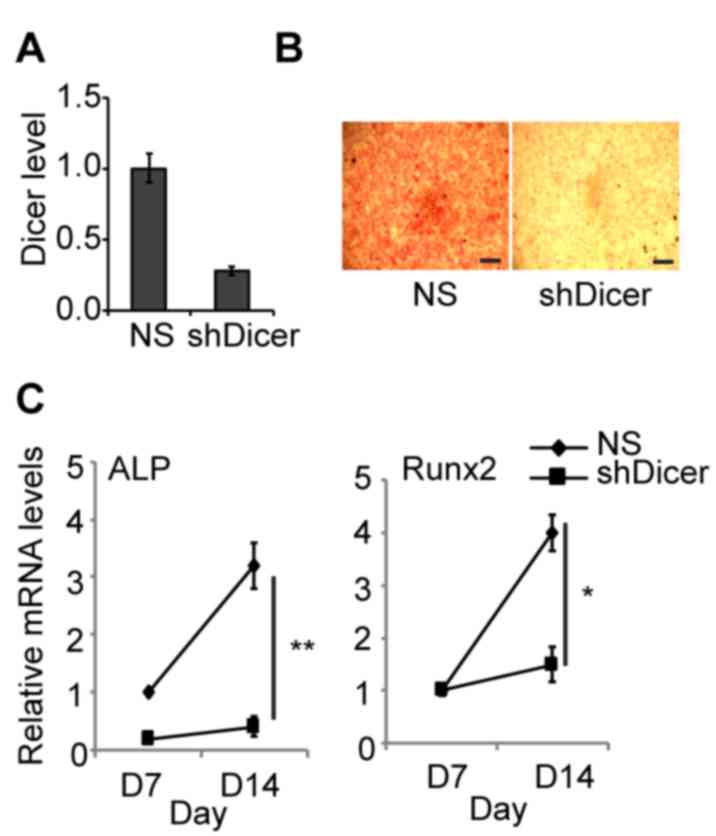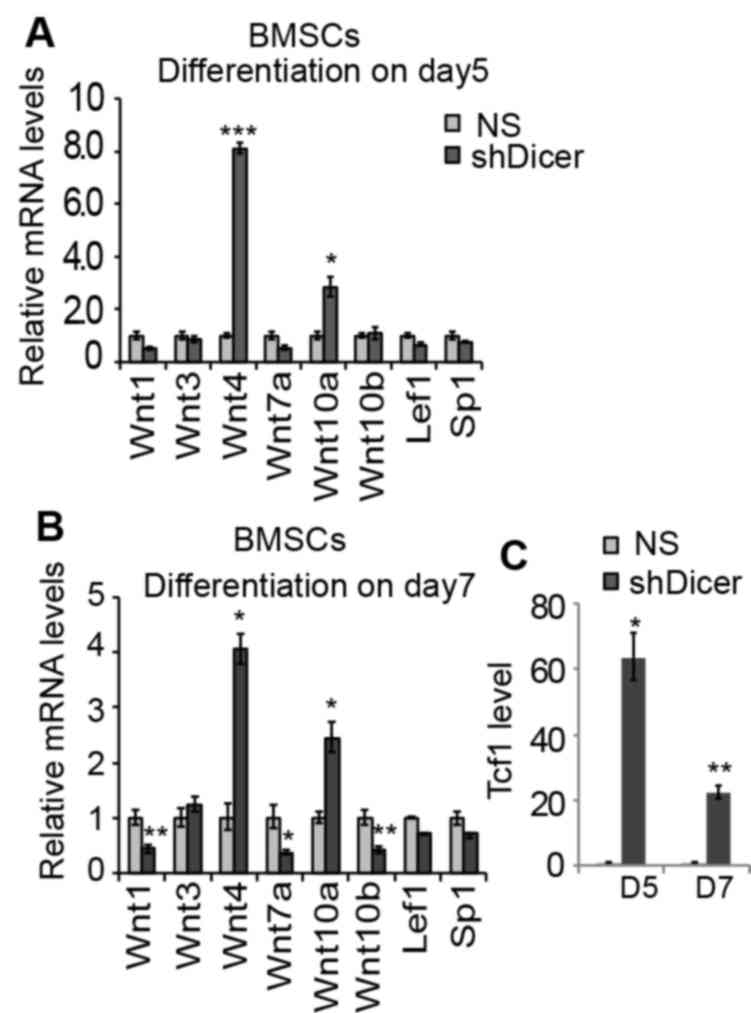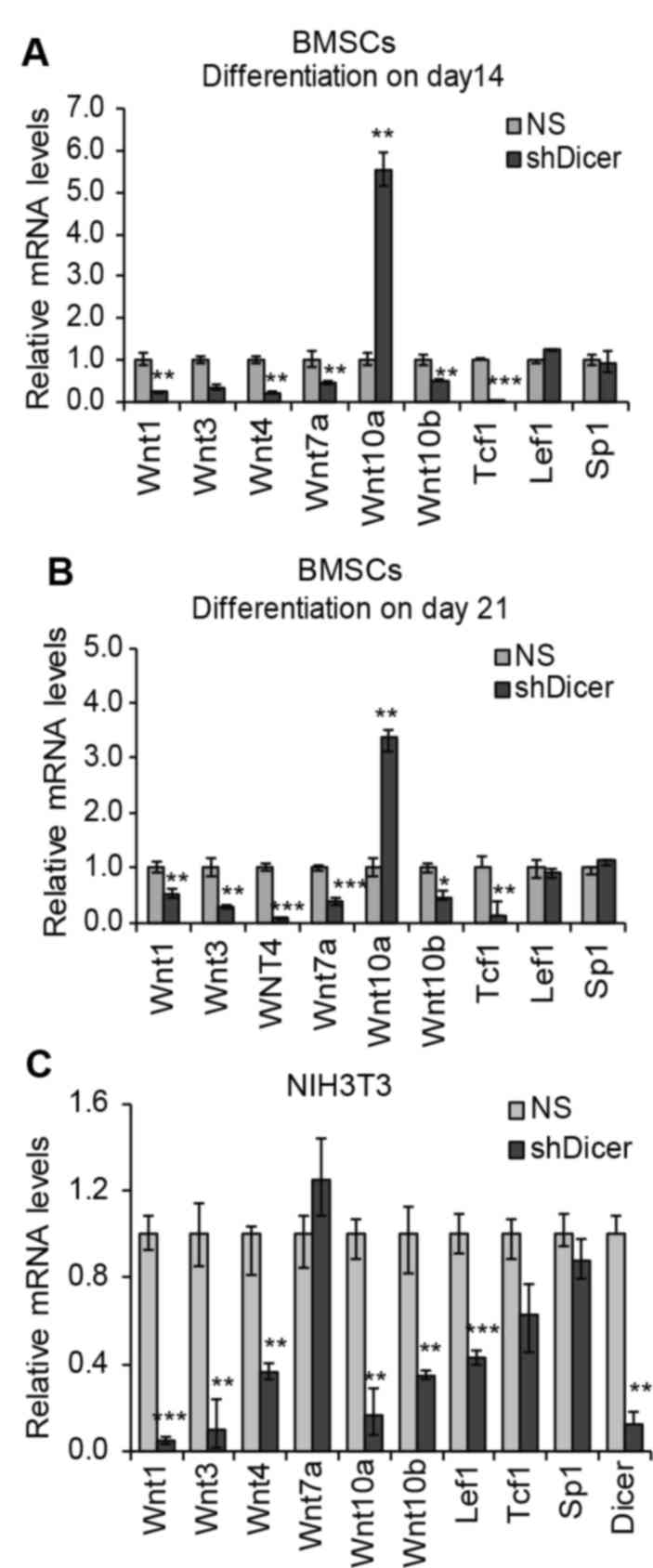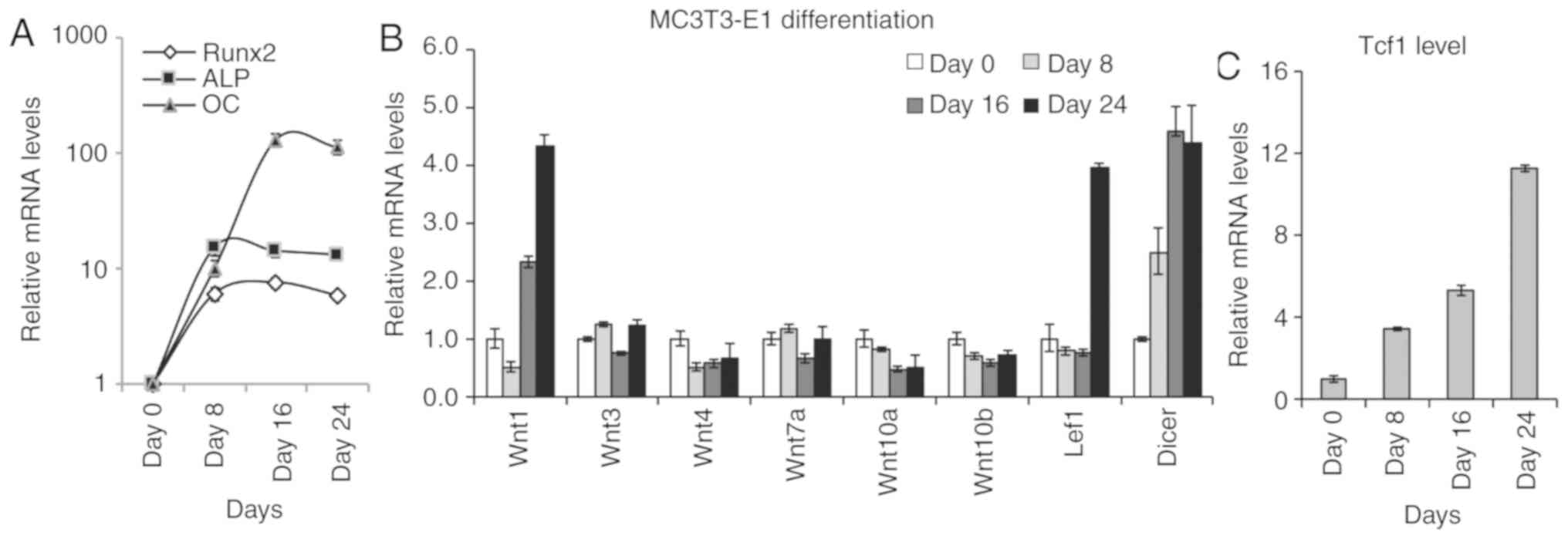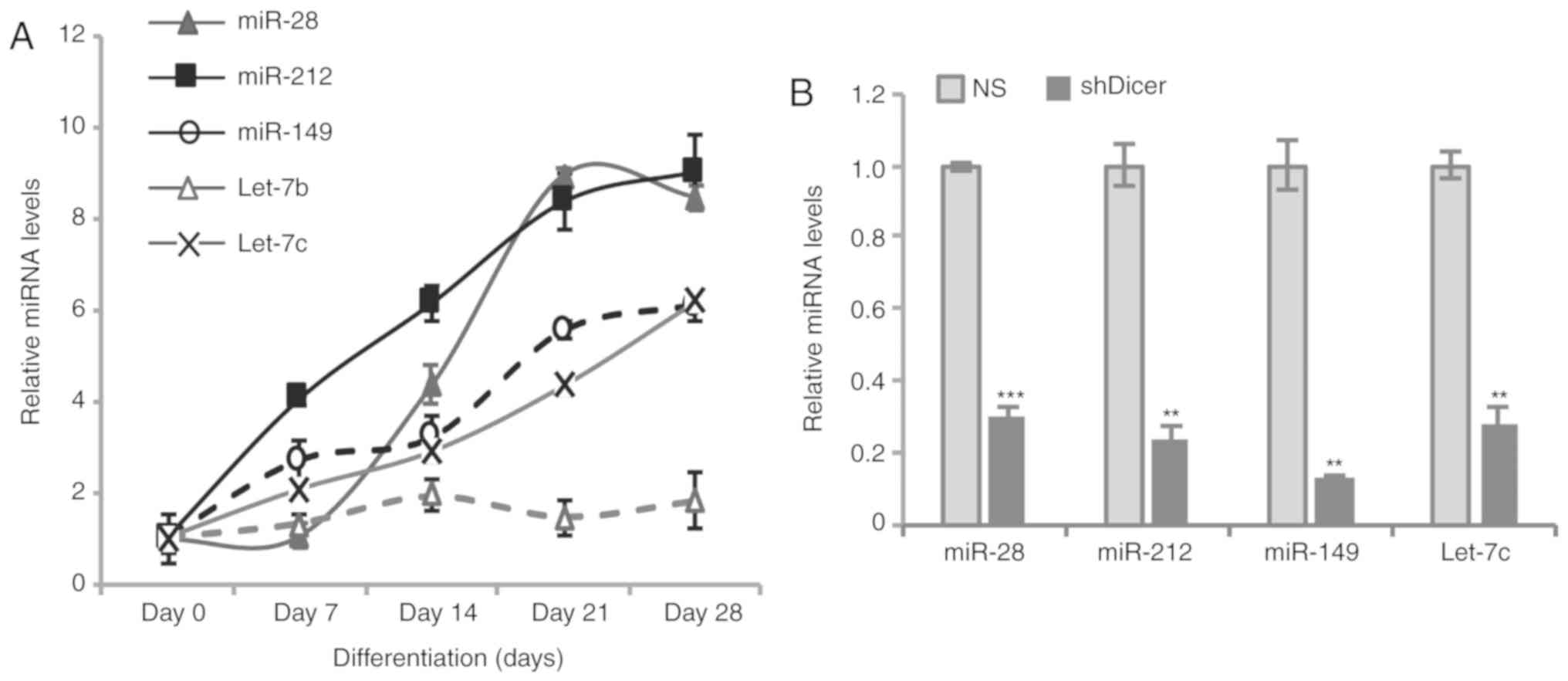|
1
|
Lian JB, Stein GS, Javed A, van Wijnen AJ,
Stein JL, Montecino M, Hassan MQ, Gaur T, Lengner CJ and Young DW:
Networks and hubs for the transcriptional control of
osteoblastogenesis. Rev Endocr Metab Disord. 7:1–16. 2006.
View Article : Google Scholar : PubMed/NCBI
|
|
2
|
Soltanoff CS, Yang S, Chen W and Li YP:
Signaling networks that control the lineage commitment and
differentiation of bone cells. Crit Rev Eukaryot Gene Expr.
19:1–46. 2009. View Article : Google Scholar : PubMed/NCBI
|
|
3
|
Maupin KA, Droscha CJ and Williams BO: A
comprehensive overview of skeletal phenotypes associated with
alterations in wnt/β-catenin signaling in humans and mice. Bone
Res. 1:27–71. 2013. View Article : Google Scholar : PubMed/NCBI
|
|
4
|
Fahiminiya S, Majewski J, Mort J, Moffatt
P, Glorieux FH and Rauch F: Mutations in WNT1 are a cause of
osteogenesis imperfecta. J Med Genet. 50:345–348. 2013. View Article : Google Scholar : PubMed/NCBI
|
|
5
|
Laine CM, Joeng KS, Campeau PM, Kiviranta
R, Tarkkonen K, Grover M, Lu JT, Pekkinen M, Wessman M, Heino TJ,
et al: WNT1 mutations in early-onset osteoporosis and osteogenesis
imperfecta. N Engl J Med. 368:1809–1816. 2013. View Article : Google Scholar : PubMed/NCBI
|
|
6
|
Zheng HF, Tobias JH, Duncan E, Evans DM,
Eriksson J, Paternoster L, Yerges-Armstrong LM, Lehtimäki T,
Bergström U, Kähönen M, et al: WNT16 influences bone mineral
density, cortical bone thickness, bone strength, and osteoporotic
fracture risk. PLoS Genet. 8:e10027452012. View Article : Google Scholar : PubMed/NCBI
|
|
7
|
Kato M, Patel MS, Levasseur R, Lobov I,
Chang BH, Glass DA II, Hartmann C, Li L, Hwang TH, Brayton CF, et
al: Cbfa1-independent decrease in osteoblast proliferation,
osteopenia, and persistent embryonic eye vascularization in mice
deficient in Lrp5, a Wnt coreceptor. J Cell Biol. 157:303–314.
2002. View Article : Google Scholar : PubMed/NCBI
|
|
8
|
Riddle RC, Diegel CR, Leslie JM, Van
Koevering KK, Faugere MC, Clemens TL and Williams BO: Lrp5 and Lrp6
exert overlapping functions in osteoblasts during postnatal bone
acquisition. PloS One. 8:e633232013. View Article : Google Scholar : PubMed/NCBI
|
|
9
|
Cui Y, Niziolek PJ, MacDonald BT, Zylstra
CR, Alenina N, Robinson DR, Zhong Z, Matthes S, Jacobsen CM, Conlon
RA, et al: Lrp5 functions in bone to regulate bone mass. Nat Med.
17:684–691. 2011. View
Article : Google Scholar : PubMed/NCBI
|
|
10
|
Lu W, Yamamoto V, Ortega B and Baltimore
D: Mammalian Ryk is a Wnt coreceptor required for stimulation of
neurite outgrowth. Cell. 119:97–108. 2004. View Article : Google Scholar : PubMed/NCBI
|
|
11
|
He X, Semenov M, Tamai K and Zeng X: LDL
receptor-related proteins 5 and 6 in Wnt/beta-catenin signaling:
arrows point the way. Development. 131:1663–1677. 2004. View Article : Google Scholar : PubMed/NCBI
|
|
12
|
Chen DQ, Cao G, Chen H, Liu D, Su W, Yu
XY, Vaziri ND, Liu XH, Bai X, Zhang L and Zhao YY: Gene and protein
expressions and metabolomics exhibit activated redox signaling and
wnt/β-catenin pathway are associated with metabolite dysfunction in
patients with chronic kidney disease. Redox Biol. 12:505–521. 2017.
View Article : Google Scholar : PubMed/NCBI
|
|
13
|
Chen L, Chen DQ, Wang M, Liu D, Chen H,
Dou F, Vaziri ND and Zhao YY: Role of RAS/Wnt/β-catenin axis
activation in the pathogenesis of podocyte injury and
tubulo-interstitial nephropathy. Chem Biol Interact. 273:56–72.
2017. View Article : Google Scholar : PubMed/NCBI
|
|
14
|
Komiya Y and Habas R: Wnt signal
transduction pathways. Organogenesis. 4:68–75. 2008. View Article : Google Scholar : PubMed/NCBI
|
|
15
|
Hovanes K, Li TW, Munguia JE, Truong T,
Milovanovic T, Lawrence Marsh J, Holcombe RF and Waterman ML:
Beta-catenin-sensitive isoforms of lymphoid enhancer factor-1 are
selectively expressed in colon cancer. Nat Genet. 28:53–57. 2001.
View Article : Google Scholar : PubMed/NCBI
|
|
16
|
Behrens J, von Kries JP, Kuhl M, Bruhn L,
Wedlich D, Grosschedl R and Birchmeier W: Functional interaction of
beta-catenin with the transcription factor Lef-1. Nature.
382:638–642. 1996. View
Article : Google Scholar : PubMed/NCBI
|
|
17
|
Wang M, Chen DQ, Chen L, Cao G, Zhao H,
Liu D, Vaziri ND, Guo Y and Zhao YY: Novel inhibitors of the
cellular RAS components, poricoic acids, target Smad3
phosphorylation and Wnt/β-catenin pathway against renal fibrosis.
Br J Pharmacol. 175:2689–2708. 2018. View Article : Google Scholar : PubMed/NCBI
|
|
18
|
Chen H, Yang T, Wang MC, Chen DQ, Yang Y
and Zhao YY: Novel RAS inhibitor 25-O-methylalisol F attenuates
epithelial-to-mesenchymal transition and tubulo-interstitial
fibrosis by selectively inhibiting TGF-β-mediated Smad3
phosphorylation. Phytomedicine. 42:207–218. 2018. View Article : Google Scholar : PubMed/NCBI
|
|
19
|
Husain A and Jeffries MA: Epigenetics and
bone remodeling. Curr Osteoporos Rep. 15:450–458. 2017. View Article : Google Scholar : PubMed/NCBI
|
|
20
|
Hassan MQ, Tye CE, Stein GS and Lian JB:
Non-coding RNAs: Epigenetic regulators of bone development and
homeostasis. Bone. 81:746–756. 2015. View Article : Google Scholar : PubMed/NCBI
|
|
21
|
Ha M and Kim VN: Regulation of microRNA
biogenesis. Nat Rev Mol Cell Biol. 15:509–524. 2014. View Article : Google Scholar : PubMed/NCBI
|
|
22
|
Gaur T, Hussain S, Mudhasani R, Parulkar
I, Colby JL, Frederick D, Kream BE, van Wijnen AJ, Stein JL, Stein
GS, et al: Dicer inactivation in osteoprogenitor cells compromises
fetal survival and bone formation, while excision in differentiated
osteoblasts increases bone mass in the adult mouse. Dev Biol.
340:10–21. 2010. View Article : Google Scholar : PubMed/NCBI
|
|
23
|
Oommen S, Otsuka-Tanaka Y, Imam N,
Kawasaki M, Kawasaki K, Jalani-Ghazani F, Anderegg A, Awatramani R,
Hindges R, Sharpe PT and Ohazama A: Distinct roles of microRNAs in
epithelium and mesenchyme during tooth development. Dev Dyn.
241:1465–1472. 2012. View Article : Google Scholar : PubMed/NCBI
|
|
24
|
Li J, Zhang Y, Zhao Q, Wang J and He X:
MicroRNA-10a influences osteoblast differentiation and angiogenesis
by regulating β-catenin expression. Cell Physiol Biochem.
37:2194–2208. 2015. View Article : Google Scholar : PubMed/NCBI
|
|
25
|
Tang X, Lin J, Wang G and Lu J:
MicroRNA-433-3p promotes osteoblast differentiation through
targeting DKK1 expression. PloS One. 12:e01798602017. View Article : Google Scholar : PubMed/NCBI
|
|
26
|
Long H, Sun B, Cheng L, Zhao S, Zhu Y,
Zhao R and Zhu J: miR-139-5p represses BMSC osteogenesis via
targeting wnt/β-catenin signaling pathway. DNA Cell Biol.
36:715–724. 2017. View Article : Google Scholar : PubMed/NCBI
|
|
27
|
Kureel J, John AA, Prakash R and Singh D:
MiR 376c inhibits osteoblastogenesis by targeting Wnt3 and
ARF-GEF-1-facilitated augmentation of beta-catenin transactivation.
J Cell Biochem. 119:3293–3303. 2018. View Article : Google Scholar : PubMed/NCBI
|
|
28
|
Cao F, Zhan J, Chen X, Zhang K, Lai R and
Feng Z: miR-214 promotes periodontal ligament stem cell
osteoblastic differentiation by modulating Wnt/β-catenin signaling.
Mol Med Rep. 16:9301–9308. 2017. View Article : Google Scholar : PubMed/NCBI
|
|
29
|
Bae JS, Gutierrez S, Narla R, Pratap J,
Devados R, van Wijnen AJ, Stein JL, Stein GS, Lian JB and Javed A:
Reconstitution of Runx2/Cbfa1-null cells identifies a requirement
for BMP2 signaling through a Runx2 functional domain during
osteoblast differentiation. J Cell Biochem. 100:434–449. 2007.
View Article : Google Scholar : PubMed/NCBI
|
|
30
|
Xu S, De Becker A, Van Camp B,
Vanderkerken K and Van Riet I: An improved harvest and in vitro
expansion protocol for murine bone marrow-derived mesenchymal stem
cells. J Biomed Biotechnol. 2010:1059402010. View Article : Google Scholar : PubMed/NCBI
|
|
31
|
Wang M, Chen DQ, Wang MC, Chen H, Chen L,
Liu D, Zhao H and Zhao YY: Poricoic acid ZA, a novel RAS inhibitor,
attenuates tubulo-interstitial fibrosis and podocyte injury by
inhibiting TGF-β/Smad signaling pathway. Phytomedicine. 36:243–253.
2017. View Article : Google Scholar : PubMed/NCBI
|
|
32
|
Livak KJ and Schmittgen TD: Analysis of
relative gene expression data using real-time quantitative PCR and
the 2(-Delta Delta C(T)) method. Methods. 25:402–408. 2001.
View Article : Google Scholar : PubMed/NCBI
|
|
33
|
Dernowsek JA, Pereira MC, Fornari TA,
Macedo C, Assis AF, Donate PB, Bombonato-Prado KF, Passos-Bueno MR
and Passos GA: Posttranscriptional interaction between miR-450a-5p
and miR-28-5p and STAT1 mRNA triggers osteoblastic differentiation
of human mesenchymal stem cells. J Cell Biochem. 118:4045–4062.
2017. View Article : Google Scholar : PubMed/NCBI
|
|
34
|
Dole NS and Delany AM: MicroRNA variants
as genetic determinants of bone mass. Bone. 84:57–68. 2016.
View Article : Google Scholar : PubMed/NCBI
|
|
35
|
de la Rica L, García-Gómez A, Comet NR,
Rodríguez-Ubreva J, Ciudad L, Vento-Tormo R, Company C,
Álvarez-Errico D, García M, Gómez-Vaquero C and Ballestar E:
NF-κB-direct activation of microRNAs with repressive effects on
monocyte-specific genes is critical for osteoclast differentiation.
Genome Biol. 16:22015. View Article : Google Scholar : PubMed/NCBI
|
|
36
|
Yuan H, Zhao H, Wang J, Zhang H, Hong L,
Li H, Che H and Zhang Z: MicroRNA let-7c-5p promotes osteogenic
differentiation of dental pulp stem cells by inhibiting
lipopolysaccharide-induced inflammation via HMGA2/PI3K/Akt signal
blockade. Clin Exp Pharmacol Physiol. 21:1440–1681. 2018.
|
|
37
|
Wei J, Li H, Wang S, Li T, Fan J, Liang X,
Li J, Han Q, Zhu L, Fan L and Zhao RC: let-7 enhances osteogenesis
and bone formation while repressing adipogenesis of human
stromal/mesenchymal stem cells by regulating HMGA2. Stem Cells Dev.
23:1452–1463. 2014. View Article : Google Scholar : PubMed/NCBI
|
|
38
|
Dweep H, Sticht C, Pandey P and Gretz N:
miRWalk-database: prediction of possible miRNA binding sites by
‘walking’ the genes of three genomes. J Biomed Inform. 44:839–847.
2011. View Article : Google Scholar : PubMed/NCBI
|
|
39
|
Agarwal V, Bell GW, Nam JW and Bartel DP:
Predicting effective microRNA target sites in mammalian mRNAs.
ELife. 4:e050052015. View Article : Google Scholar :
|
|
40
|
Nusse R and Clevers H: Wnt/β-catenin
signaling, disease, and emerging therapeutic modalities. Cell.
169:985–999. 2017. View Article : Google Scholar : PubMed/NCBI
|
|
41
|
Zhao YY, Cheng XL, Vaziri ND, Liu S and
Lin RC: UPLC-based metabonomic applications for discovering
biomarkers of diseases in clinical chemistry. Clin Biochem.
47:16–26. 2014. View Article : Google Scholar : PubMed/NCBI
|
|
42
|
Chen L, Su W, Chen H, Chen DQ, Wang M, Guo
Y and Zhao YY: Proteomics for biomarker identification and clinical
application in kidney disease. Adv Clin Chem. 85:91–113. 2018.
View Article : Google Scholar : PubMed/NCBI
|
|
43
|
Cawthorn WP, Bree AJ, Yao Y, Du B, Hemati
N, Martinez-Santibañez G and MacDougald OA: Wnt6, Wnt10a and Wnt10b
inhibit adipogenesis and stimulate osteoblastogenesis through a
β-catenin-dependent mechanism. Bone. 50:477–489. 2012. View Article : Google Scholar : PubMed/NCBI
|
|
44
|
Shao JS, Cheng SL, Pingsterhaus JM,
Charlton-Kachigian N, Loewy AP and Towler DA: Msx2 promotes
cardiovascular calcification by activating paracrine Wnt signals. J
Clin Invest. 115:1210–1220. 2005. View Article : Google Scholar : PubMed/NCBI
|
|
45
|
Adamska M, MacDonald BT, Sarmast ZH,
Oliver ER and Meisler MH: En1 and Wnt7a interact with Dkk1 during
limb development in the mouse. Dev Biol. 272:134–144. 2004.
View Article : Google Scholar : PubMed/NCBI
|
|
46
|
Minear S, Leucht P, Jiang J, Liu B, Zeng
A, Fuerer C, Nusse R and Helms JA: Wnt proteins promote bone
regeneration. Sci Transl Med. 2:29ra302010. View Article : Google Scholar : PubMed/NCBI
|
|
47
|
Rauch F: The brains of the bones: How
osteocytes use WNT1 to control bone formation. J Clin Invest.
127:2539–2540. 2017. View Article : Google Scholar : PubMed/NCBI
|
|
48
|
Chang J, Sonoyama W, Wang Z, Jin Q, Zhang
C, Krebsbach PH, Giannobile W, Shi S and Wang CY: Noncanonical
Wnt-4 signaling enhances bone regeneration of mesenchymal stem
cells in craniofacial defects through activation of p38 MAPK. J
Biol Chem. 282:30938–30948. 2007. View Article : Google Scholar : PubMed/NCBI
|
|
49
|
Yu B, Chang J, Liu Y, Li J, Kevork K,
Al-Hezaimi K, Graves DT, Park NH and Wang CY: Wnt4 signaling
prevents skeletal aging and inflammation by inhibiting nuclear
factor-κB. Nat Med. 20:1009–1017. 2014. View Article : Google Scholar : PubMed/NCBI
|
|
50
|
Chen YS, Wu R, Yang X, Kou S, MacDougald
OA, Yu L, Shi H and Xue B: Inhibiting DNA methylation switches
adipogenesis to osteoblastogenesis by activating Wnt10a. Sci Rep.
6:252832016. View Article : Google Scholar : PubMed/NCBI
|
|
51
|
Kawano Y and Kypta R: Secreted antagonists
of the Wnt signalling pathway. J Cell Sci. 116:2627–2634. 2003.
View Article : Google Scholar : PubMed/NCBI
|















